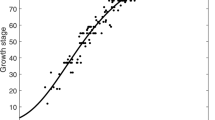Abstract
In Argentina, head blight is a highly risky disease (caused by Fusarium graminearum), although its occurrence is sporadic depending on prevalent environmental variables. These traits stimulated the development of predictive models of head blight occurrence which would help growers in the selection of control strategies. Empirical equations for predicting head blight incidence were developed at Pergamino (33° 56′ S, 60° 30′ W) associating temperature and moisture variables with mean disease data. Recently a new fundamental-empirical approach for estimating Fusarium index (incidence% x severity%/100) was developed using data of Pergamino and Marcos Juarez (32° 41′ S, 62°07′ W). In this study our objective was to validate both approaches at three more southern locations: La Dulce (38° 10′ S, 58° 00′ W), Miramar (38° 00′ S, 57° 33′ W) and Balcarce (37° 45′ S, 58° 18W), for the 2001 crop season. Examining partial and mean deviation values between observed and predicted incidence data, an underestimation especially at La Dulce was assessed. A clear improvement of incidence goodness of fit estimations was obtained decreasing the heat accumulation defining the length of the wheat critical period for infection. Employing this last critical period length for the fundamental-empirical approach led to satisfactory Fusarium index predictions. This study showed that both approaches developed at northern locations of the Pampas region can be portable and useful for predicting disease intensity at more southern locations, making only a few changes.
Similar content being viewed by others
References
Andersen, A.L. 1948: The development of Gibberella zeae head blight of wheat. Phytopathology 38:599–611.
Annone, J.G. and Frutos, E. 1988: Estimation del efecto del ‘golpe bianco’ del trigo (Fusarium graminearurn) sobre la production de granos de un grupo de variedades comerciales. Informe técnico N° 218. 23 pp. E.E.A. INTA Pergamino.
Bai, G.H. and Shaner, G. 1994: Scab of Wheat: Prospects for control. Plant Dis. 78: 760–766.
Carranza, M.R., Lori, G.A. and Sisterna, M.N. 2002: Fusaria involved in the head blight complex of wheat in Argentina. Fitopatologia 37: 164–168
Cook, R.J. and Veseth, R.J. 1991: Wheat health management. Plant health management series. APS Press.
De Wolf, E.D., Madden, L.V. and Lipps, P.E. 2003: Risk assessment models for wheat Fusarium head blight epidemics based on within-season weather data. Phytopathology 93:428–435.
Francl, L., Shaner, G., Bergstrom, G., Gilbert, J., Pedersen, W., Dill- Macky, R., Sweets, L., Corwin, B., Jin, Y., Gallenberg, D. and Wiersma, J. 1999: Daily inoculum levels of Gibberella zeae on wheat spikes. Plant Dis. 83:622–666.
Galich, M.T.V. de and Galich, A.N. 1994: Enfermedades del trigo en el área sur de Santa Fé y Córdoba. EEA Marcos Juarez. INTA Information para extension N° 5. pp. 1–7.
Galich, A.N. and Galich, M.T.V. de. 1996: Enfermedades del trigo en el area central norte de la región cerealera argentina. EEA INTA Marcos Juarez. Informe Técnico N° 121. pp 1–25.
Moschini, R.C. and Fortugno, C. 1996: Predicting wheat head blight incidence using models based on meteorological factors in Pergamino, Argentina. European Journal of Plant Pathology 102:211–218.
Moschini R.C., Pioli R., Carmona, M. A. and Sacchi, O. 2001: Empirical predictions of wheat head blight in the northern Argentinean Pampas region. Crop Sci. 41: 1541–1545.
Moschini, R.C, Galich, M.T.V. de, Annone, J.G., Polidoro, O. 2002: Enfoque Fundamental-Empírico para estimar la evolutión del Indice de Fusarium en trigo. Revista RIA, 31(3):39–53
Pomeranz, Y., Bechtel, D.B., Sauer, D.B. and Scitz, L.M. 1990: Fusarium head blight (scab) in cereal grains. Adv. Cereal Sci. Technology 10: 373–433.
Reis, E.M. 1987: Biología y epidemiologia de Gibberella zeae en trigo. In: M.M. Kohli (ed.). Taller sobre la fusariosis de la espiga en America del Sur, CIMMYT, Mexico D.F., 144pp.
Reis, E.M and Carmona, M. 2002: Fusariosis del trigo. 22 pp.
Sutton, J.C. 1982: Epidemiology of wheat head blight and maize ear rot caused by Fusarium graminearum. Can. J. Plant Path. 4: 195–209.
Wiersma, J.V., Peters, E.L., Hanson, M.L., Bouvette, L.J. and Busch, R.H. 1996: Fusarium head blight in hard red spring wheat: cultivars responses to natural epidemics. Agron. J. 88: 223–230.
Wiese, M.V. 1987: Scab (Head Blight). In Compendium of wheat disease, pp 16–18. Second Ed. American Phytopathological Society, St. Paul, MN.
Author information
Authors and Affiliations
Corresponding author
Rights and permissions
About this article
Cite this article
Moschini, R.C., Carranza, M.R. & Carmona, M.A. Meteorological-Based Predictions of Wheat Head Blight Epidemic in the Southern Argentinean Pampas Region. CEREAL RESEARCH COMMUNICATIONS 32, 45–52 (2004). https://doi.org/10.1007/BF03543279
Received:
Accepted:
Published:
Issue Date:
DOI: https://doi.org/10.1007/BF03543279




